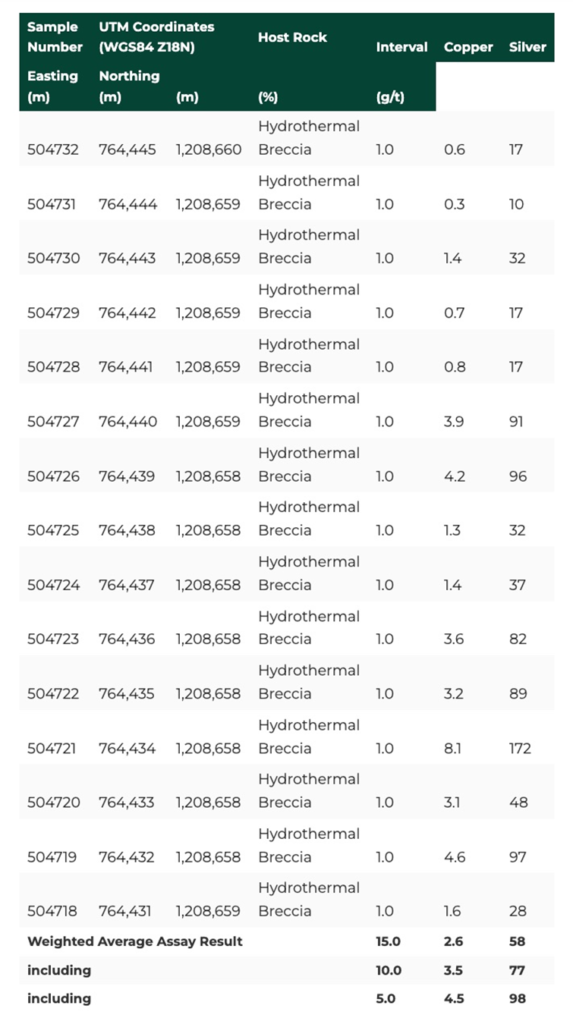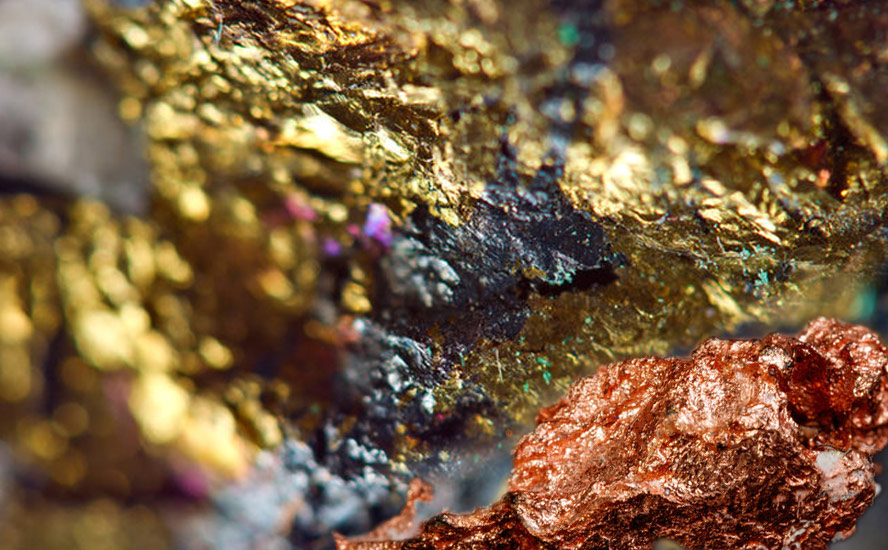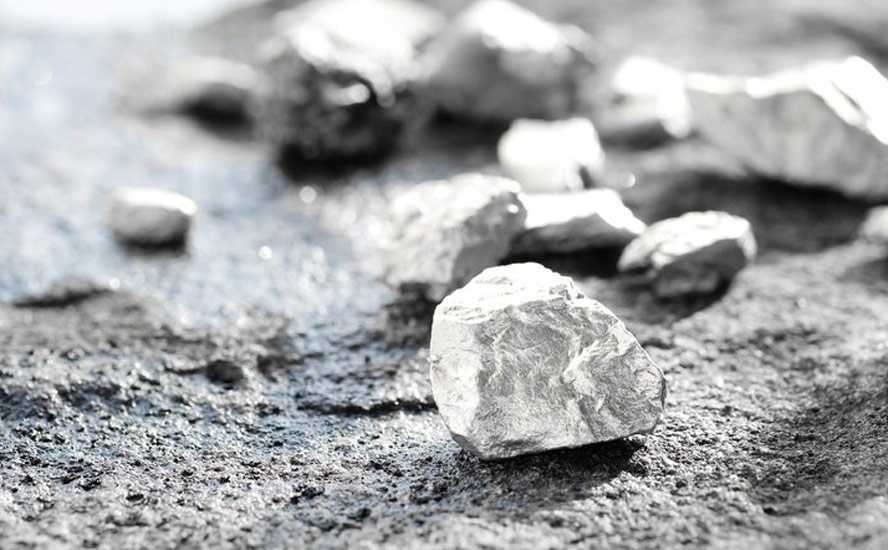Max Resource samples high-grade copper-silver from newly discovered AM-08 target – Richard Mills
2023.11.23
In mineral exploration, a promising discovery can often be validated by the sampling/drill results that follow. This is what Max Resource Corp. (TSXV:MAX; OTC:MXROF; Frankfurt:M1D2) has done at its newly discovered AM-08 target at its CESAR copper-silver project in northeastern Colombia.
The target is about 7 km southeast of the AM-07 discovery made public in June.
AM-08 represents the eighth discovery by Max in the 20-km-long AM District, which forms the northern end of the CESAR property.

This week, Max reported assay results from samples collected at the AM-08 target. Continuous rock chip sampling across the width of the structurally controlled mineralization returned 2.6% copper and 58 grams per tonne (g/t) silver over 15 meters. Within this 15m interval, there was a higher-grade 3.5% copper and 77 g/t silver over 10m, and within the 10m interval, 8.1% copper and 172 g/t silver over 1m.
Continuous chip channel sampling across mineralized outcrops at several locations west of the primary occurrence returned values of 2.5% copper + 48 g/t silver over 2m; 1.8% copper + 18 g/t silver over 1.8m; and 1.1% copper + 16 g/t silver over 5.3m.


According to Max, AM-08 has two styles of copper-silver mineralization: structurally controlled and stratiform sediment hosted. Stratiform mineralization at AM-08 has been mapped along strike for 400 meters.
The structurally controlled mineralization is hosted in a north-northeast striking fault and is thickest where it intersects a north-northwest striking fault. The primary copper mineral is chalcocite which occurs in multiple veins up to 3 cm thick.
Stratiform mineralization is observed where the mineralized structure comes into contract with sedimentary rocks or lithological contacts. Copper minerals include chalcocite and bornite which form irregular veins that are concordant with the strata. The strike and dip of bedding in the AM-08 area is measured at N30⁰- 60⁰E and 30⁰NE respectively.
Assay results from continuous chip channel samples collected at four locations at the AM-08 target are presented in Table 1 through 4:




“The assay results from four outcrops at AM-08 are exceptional and make this a top-priority target for Max. The high-grade results along with the combination of structural and stratiform mineralization provides the Company with the potential for significant deposits,” said Max’s CEO Brett Matich.
“Field crews will now focus on expanding the stratiform mineralization at the AM District, along strike and on identifying other locations where the stratiform and structural mineralization intersect to create wider zones,” he concluded.

CESAR project
The CESAR project is situated along the copper-silver-rich Cesar Basin of northeastern Colombia. This region provides access to major infrastructure resulting from oil & gas and mining operations.
Max was the first to recognize the potential for the Cesar Basin and the company’s land package now spans more than 1,150 km of geology prospective for sedimentary-hosted copper and silver deposits.
Max’s field teams have so far identified 27 targets across three separate districts of the 120-km Cesar copper-silver belt: AM, Conejo and URU.
Initial efforts have been concentrated on those targets with the greatest size potential with work that includes the following field activities:
- Systematic chip and channel sampling of the mineralized outcrops;
- Detailed geological and structural mapping of each showing;
- Trenching where possible to expose additional mineralization;
- Target scale prospecting and soil sampling;
- Ground geophysical surveys.
The company announced on Nov. 8 that it has secured 12 more applications for mining concessions covering over 132 square kilometers. It means CESAR now spans 120 along strike, from the previous 90 km, in a north-northeast/ south-southwest direction.
In addition, Max has acquired the royalties associated with 19 mining concessions and 31 mining concession applications at CESAR.
Bay Street Mineral Corp held an underlying 3% net smelter royalty over 19 mining concessions covering 184 square km, and 31 mining concession applications covering 796 square km.
The royalty acquisition is through a share exchange agreement Max executed with Bay Street, whereby Max acquires all the issued and outstanding shares of Bay Street, an arm’s length Canadian corporation, in exchange for 14 million Max shares.
While Max has demonstrated that the Cesar Basin is fertile for copper-silver mineralization over a large area, only a fraction of the basin has been explored. Therefore, Max says its geological teams are dedicated to regional exploration, with the goal of discovering additional copper-silver prospects over 1,000 square kilometers.
Currently, there are two depositional models at the CESAR project. Drilling at AM has confirmed that the sediment-hosted stratiform copper-silver mineralization found in the north end of the project (AM and Conejo) is analogous to the Central African Copper Belt (CACB) and the Kupferschiefer copper-silver deposits of central Europe. Work at the south of the project has identified mineralization hosted along structures (faults) within the volcanic units of the La Quinta formation. It is theorized that the structurally hosted mineralization may represent the feeder system for the stratiform mineralization observed in the sedimentary layers.
Make no mistake. Sedimentary-hosted copper deposits can have staggering size and value. It’s estimated that nearly 50% of the copper known to exist in sediment-hosted deposits is contained in the CACB, headlined by Ivanhoe’s 95-billion-pound Kamoa-Kakula discovery in the Democratic Republic of Congo.
Kupferschiefer, considered to be the world’s largest silver producer and Europe’s largest copper source, is an orebody ranging from 0.5 to 5.5m thick at depths of 500m, grading 1.49% copper and 48.6 g/t silver. The silver yield is almost twice the production of the world’s second-largest silver mine.
Four new targets
In late October, interpretation of preliminary airborne magnetic-radiometric survey data identified four new targets within the AM district. The targets are AM-9 to AM-12, seen on the second-from-the-top map above.
According to Max, the success and effectiveness of the airborne survey has resulted in Max extending the survey by 6,000 line-km; it will now cover all three districts of the Cesar Project: AM, Conejo and URU.
The first 4,000 line-km of magnetic and radiometric data were collected along tightly spaced lines separated by 135 m, providing Max with two detailed data sets that are packed with geological information important to the process of mineral discovery and development.
The airborne survey is targeting the La Quinta formation, a thick sequence of Jurassic-age (163 to 191 million-years before present) volcanic and sedimentary rocks in the Cesar Basin. Copper and silver mineralization has been discovered throughout the entire formation, but it is the sedimentary sequences that are of the greatest interest.
The four new targets were identified within the AM District where the sedimentary rocks are prevalent. The targets were identified in the airborne geophysical data by looking for structural patterns in unexplored areas of the CESAR property that are similar to those seen where mineralization is known to exist.
Radiometric surveys detect and map radiation from rocks and soils. The gamma radiation occurs from the natural decay of elements like uranium, thorium and potassium.
Max Resource unlocking the puzzle of a massive sedimentary basin
Magnetic surveys measure the spatial variations of the magnetic field. The results reflect the variations in the magnetic properties of the underlying rocks, and provide valuable information about their compositions and the structure of the Earth’s crust.
Magnetic and radiometric data were recorded simultaneously during the fixed-wing airborne survey. Max says the data sets will be instrumental for understanding the faults that act as conduits for mineralized fluids to infiltrate the sedimentary rocks and precipitate the copper-silver minerals.
Based on the strength of the data, Max has decided to extend the survey to cover the two districts south of AM: Conejo and URU. In total, 10,000 line-km of data covering 1,150 sq-km will be collected over all three districts of the CESAR copper-silver project.
“It is clear, even at this early stage, the techniques employed by Max will produce essential data sets for our continuing exploration efforts at CESAR,” said Max’s CEO Brett Matich, in the Oct 24 news. “The information from this survey will allow Max to evaluate its growing land package and pin-point new target areas for follow-up exploration. Equally important, the data will be used to expand existing targets through better understanding of their structural environment.”
RT Gold project
In addition to CESAR, Max controls the RT Gold property (100% earn-in) in Peru, encompassing a bulk tonnage primary gold porphyry zone, and 3 km to the northwest, a gold-bearing massive sulfide zone. Historical drilling in 2001 returned values ranging from 3.1 to 118.1 g/t gold over core lengths from 2.2 to 36.0m.
RT is located 760 km north-northwest of Lima in the district of Tabaconas, in the northern part of the Department of Cajamarca (hence the project is named “Rio Tabaconas”, or simply RT). It consists of two contiguous concessions that cover an area of 980 and 1,000 hectares, respectively.
The property sits along the Cajamarca metallogenic belt, extending north from central Peru into southern Ecuador. This prolific belt hosts a number of world-class deposits (see map below).

In Ecuador, there is the Fruta Del Norte discovery (15.5Moz Au), Mirador (2.7Mt Cu, 2.74Moz Au), and the new discovery by Solaris Resources at its Warintza deposit (2.7Mt Cu, 0.9Moz Au). On the Peruvian side, it has Newmont’s Yanacocha (8.61Moz Au).
Recently, Max filed a technical report that it believes “validates the true potential of the two distinct gold-bearing systems” found on the RT property — namely, the Cerro bulk-tonnage porphyry zone and the Tablon massive sulfide zone.
Cerro hosts several mineralized zones. Soil geochemistry has outlined a 2 km by 1.5 km gold anomaly that is open in all directions, with gold values ranging from 0.1 to 4.0 grams per tonne (g/t). The soil geochemistry is coincident with IP chargeability. A continuous channel sample across the zone assayed 3.3 g/t gold over a width of 25.5m.
Tablon, located 3 km to the northwest, was drilled in 2001 by Golden Alliance Resources Corp. In February 2021, Max obtained the historical drill core and commenced a re-logging and resampling campaign. The resampling confirmed thickness and grade of the 2001 drill intercepts and reasonably well reproduced the reported grades.
Results included high-grade gold values ranging from 3.1 to 118.1 g/t gold over core lengths from 2.2 to 36.0m. One intercept returned a metallics reassay value of 186 g/t gold over 2.2m, indicating the presence of coarse gold.
The next step for the project is an environmental survey, followed by drilling application.
Max Resource Corp.
TSXV:MAX; OTC:MXROF; Frankfurt:M1D2
Cdn$0.125 2023.11.22
Shares Outstanding 161.9m
Market cap Cdn$20.2m
MAX website
Richard (Rick) Mills
aheadoftheherd.com
subscribe to my free newsletter
Legal Notice / Disclaimer
Ahead of the Herd newsletter, aheadoftheherd.com, hereafter known as AOTH.
Please read the entire Disclaimer carefully before you use this website or read the newsletter. If you do not agree to all the AOTH/Richard Mills Disclaimer, do not access/read this website/newsletter/article, or any of its pages. By reading/using this AOTH/Richard Mills website/newsletter/article, and whether you actually read this Disclaimer, you are deemed to have accepted it.
Any AOTH/Richard Mills document is not, and should not be, construed as an offer to sell or the solicitation of an offer to purchase or subscribe for any investment.
AOTH/Richard Mills has based this document on information obtained from sources he believes to be reliable, but which has not been independently verified.
AOTH/Richard Mills makes no guarantee, representation or warranty and accepts no responsibility or liability as to its accuracy or completeness.
Expressions of opinion are those of AOTH/Richard Mills only and are subject to change without notice.
AOTH/Richard Mills assumes no warranty, liability or guarantee for the current relevance, correctness or completeness of any information provided within this Report and will not be held liable for the consequence of reliance upon any opinion or statement contained herein or any omission.
Furthermore, AOTH/Richard Mills assumes no liability for any direct or indirect loss or damage for lost profit, which you may incur as a result of the use and existence of the information provided within this AOTH/Richard Mills Report.
You agree that by reading AOTH/Richard Mills articles, you are acting at your OWN RISK. In no event should AOTH/Richard Mills liable for any direct or indirect trading losses caused by any information contained in AOTH/Richard Mills articles. Information in AOTH/Richard Mills articles is not an offer to sell or a solicitation of an offer to buy any security. AOTH/Richard Mills is not suggesting the transacting of any financial instruments.
Our publications are not a recommendation to buy or sell a security – no information posted on this site is to be considered investment advice or a recommendation to do anything involving finance or money aside from performing your own due diligence and consulting with your personal registered broker/financial advisor.
AOTH/Richard Mills recommends that before investing in any securities, you consult with a professional financial planner or advisor, and that you should conduct a complete and independent investigation before investing in any security after prudent consideration of all pertinent risks. Ahead of the Herd is not a registered broker, dealer, analyst, or advisor. We hold no investment licenses and may not sell, offer to sell, or offer to buy any security.
Richard owns shares of Max Resource Corp. (TSXV:MAX). MAX is a paid advertiser on his site aheadoftheherd.com
This article is issued on behalf of MAX
Legal Notice / Disclaimer
Ahead of the Herd newsletter, aheadoftheherd.com, hereafter known as AOTH.Please read the entire Disclaimer carefully before you use this website or read the newsletter. If you do not agree to all the AOTH/Richard Mills Disclaimer, do not access/read this website/newsletter/article, or any of its pages. By reading/using this AOTH/Richard Mills website/newsletter/article, and whether you actually read this Disclaimer, you are deemed to have accepted it.




























